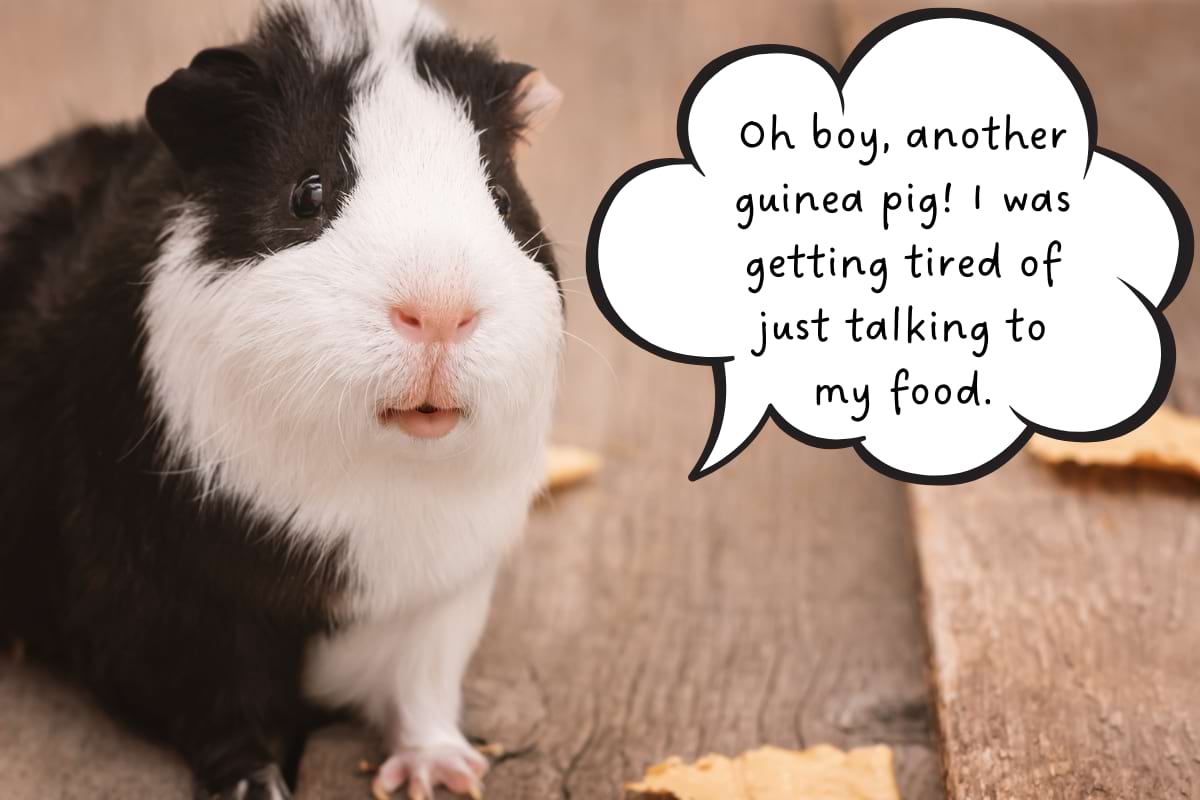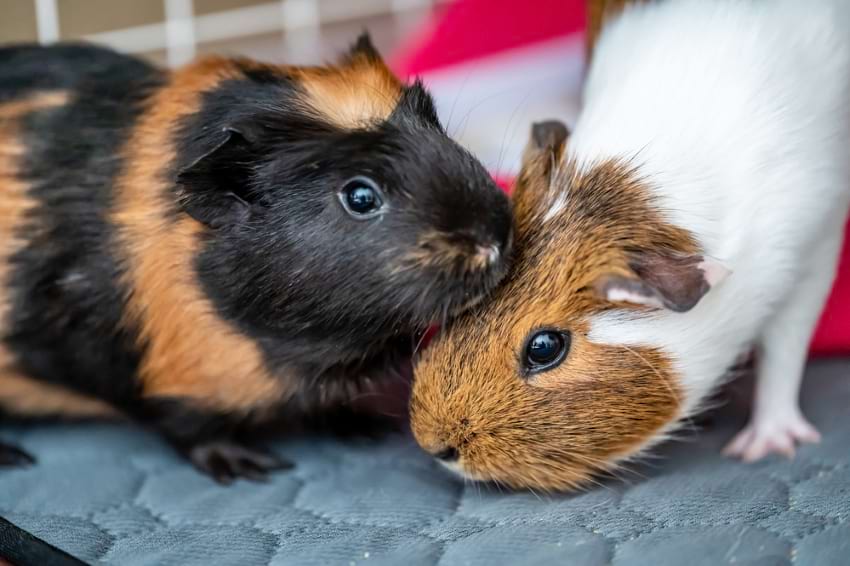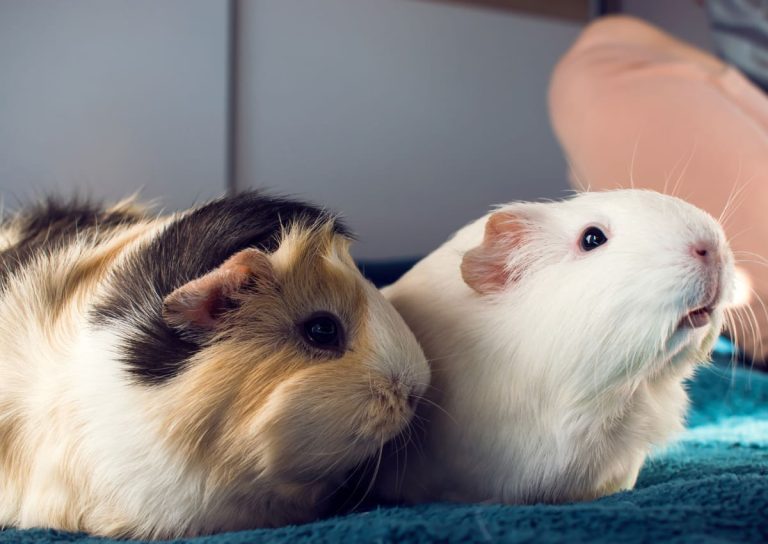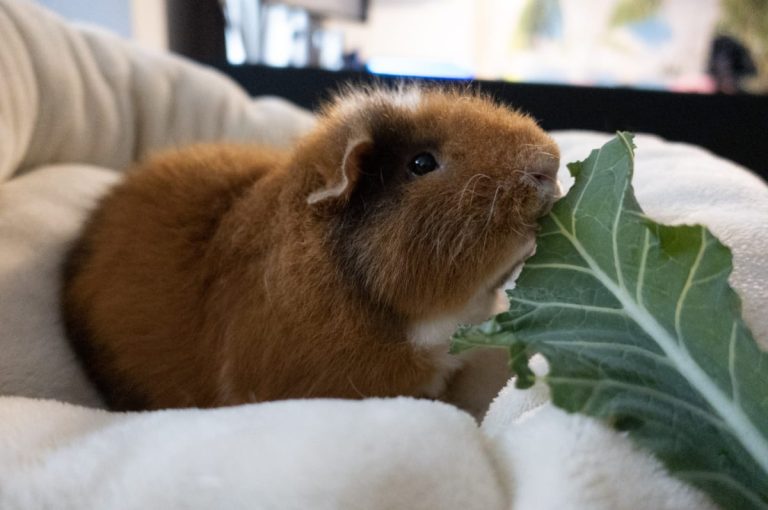Fluffy, Meet Fluffier: How to Introduce Guinea Pigs in 4 Steps

Guinea pigs are social creatures who thrive on close relationships and frequent interaction. In the wild, these little animals live in herds, where a group of “Cavies” is called a “Muddle.”
Similar to their wild counterparts, domestic guineas prefer the companionship of a fellow fluffy friend. Adopting a second guinea can have a positive effect on your pet… of course, that’s assuming everything goes well.
Although it’s impossible to tell beforehand, some pigs are territorial, mostly males. To ensure that introductions go smoothly, you’ll need to proceed cautiously with this major change.
Before bringing home another tiny cave dweller, you’ll want to read through our guidelines and take the proper precautions for a (hopefully!) seamless transition.
Understanding the Importance of Gender
First, before any introductions whatsoever, you must determine the sex of your guinea pigs. Since gender plays a significant role in interaction, you cannot skip over this vital step. More often than not, pet shop employees have little to no training on how to determine gender correctly.
To play it safe and avoid the surprise of an unplanned litter, don’t count on their input. Instead, have a veterinarian check your guineas, as they know precisely what “bits and parts” will determine if you have a pretty Princess Pigglet or a regal Prince Pigglesworth.
Introducing Old and Young, Male and Female, and Every Combination in-between
Ideally, before adopting another guinea friend, you’ll want to understand which gender combinations are the least stressful. The easiest duo to pair up would be two same-sex baby piglets. They’re very young, so they essentially start off their relationship with a “blank slate.”
Pairing an older guinea with a same-gender baby is a good match, as well. In this case, the established cavy’s dominance isn’t questioned by the youngster, and therefore not challenged, so the relationship is less strained.
It’s not recommended to house a male and a female together, as you would need to neuter the male to eliminate the chance of a litter which is risky for your pet. In case you’re unaware of guinea birthrates, a female “sow” can birth up to five litters per year. Multiply that by 5-7 years (the average lifespan of a piggy), and that makes for a serious amount of fluffy babies, especially considering a litter can consist of up to eight tiny fluffballs.
Above all else, it isn’t recommended to introduce a single female to a group of males. In this instance, the males will fight over the female in order to win the right to mate. The bottom line is, cavies are rapid breeders. Placing an unsterilized male and female together will result in a whole bunch of babies.
When introducing two adult males, you’ll need spacious accommodations because of their territorial instincts. The bigger the cage, the better, to ensure the males live in harmony. Each pig will require their own distinct spaces, areas to play, sleep, hide, and eat. Basically, you’ll need to give them two of everything, from hiding houses to feeding bowls, to make sure one guinea doesn’t confine the other.
How to Introduce Guinea Pigs in 4 Steps

1. The Quarantine
For the first two weeks, keep your guineas separate. If your newly adopted guinea pig has an illness that could be transmitted to your guinea pigs, this will eliminate that risk. Guinea pigs from pet stores are usually housed with many other piggies, which increases the risk of them carrying a bug that might be transferred to your pets.
Use a second cage for your adoptee and place it in the other room. If you can’t keep it in the other room, try to keep them as far away from each other as possible.
2. The Neutral Ground Introduction
After the quarantine phase, it’s time for your furry baby to meet their new cage mate.
Don’t place the new piggy into the cage as this will result in undue stress. Instead, your goal is to ease the transition to a new environment, and adding a new animal to an established cage will most likely result in a territorial standoff. Guinea pigs are cute but don’t be fooled – they know how to fight dirty!
Find a neutral area, like the bathroom or the kitchen, places where you normally don’t bring your pets. Neutral ground removes the threat of a “hostile take-over,” and is thus less stressful.
3. The Treat Distraction
Set-up the center of your neutral zone for a great introduction by prepping it with yummy munchables like hay, treats, and veggies. Doing so gives them a delicious distraction from a possibly stressful situation. In the event of a fight, use a towel to separate your pets.
4. The Harmonious Balance
If your pets interact without a skirmish for about two hours, count yourself a lucky piggy parent! At this point, you can go ahead and return them to the same cage.
However, before doing so, you’ll want to thoroughly clean the cage with a pet-safe cleaner to remove its original scent, as well as rearrange the environment to make it a “new” habitat for both cavies.
Signs of Aggression Versus Normal Interaction
Introducing guinea pigs can run into snags, even though you follow guidelines closely, recreating them step by step. What many people don’t take into account is individual pet personality and temperament. Pets have personalities, just like you and me. No matter how much you wish it, your pets may simply not get along. That’s why it’s important to differentiate between signs of aggression and normal, healthy interaction.
Of course, you’ll want to keep a close eye on your fuzzy duo, but don’t intervene unless absolutely necessary.
Mounting or jumping over one another isn’t always a sign of aggression, though these actions can lead to a physical altercation. Watch their behavior and only intervene if it leads to fighting.
Other typical signs, like bottom-sniffing, nudging, chasing, squealing, and teeth chattering are signs of normal, non-threatening behavior. These are all common methods of defining the boundaries, and sometimes hierarchy, of a new cavy relationship.
Again, unless there’s an intense argument and blood is drawn, do not separate them, they’re just trying to work out this situation.

What to Do When Things Aren’t Working Out
To bond two guinea pigs successfully, you should do one bonding session in a large, neutral area over a period of several hours. Avoid repeatedly introducing them and then separating them. This is stressful for them and can lead to more fighting. Instead, it’s better to keep them apart until you’re ready to house them together and then have one day of introductions.
After the introduction, it’s recommended to keep them together unless they start fighting to the point of drawing blood. If this happens, they should be kept apart permanently.
The Heartbreak of a Lonely Cavy
Did you know that guinea pigs are so dependant on social interaction that, when left alone, they can die of loneliness?
After the death of her companion, my sweet little Muffy was positively heartbroken. The day that Lilly passed away, Muffy stopped her vocalizations and refused to eat, a deep sadness that lasted for weeks. It took some time, but with our increased daily interactions, my family was able to help pull her out of her lonely state. Eventually, she became vocal again and actively sought out our company.
Without a doubt, guinea pigs thrive on companionship, as I have seen with my very eyes. So, if you’re looking to find a furry friend for your furry bestie, you’re bound to reap positive benefits.







This is very helpful information. Thank you!
Glad you found it useful 🙂